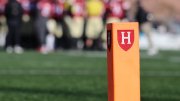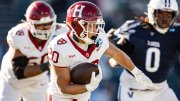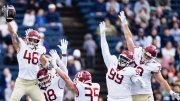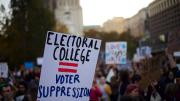On Friday, June 6, California’s Judge Claudia Wilken approved a settlement in House v. National Collegiate Athletic Association (NCAA), ending a five-year legal saga and paving the way for colleges to directly pay student athletes. The House settlement (which, under the name of Arizona State University swimmer Grant House, combined three separate suits) has major implications for collegiate sports, but its impact on Harvard is fairly minimal. In January, the Ivy League announced it was opting out of the settlement, exempting it from most of the forward-looking provisions, but still requiring it to pay damages.
As a member of the NCAA’s top division, Harvard must pay part of the nearly $2.8 billion owed to athletes who competed between 2016 and 2024. That money makes up for the fact that, until 2021, students were not allowed to make money from their own name, image, and likeness (NIL) and that, until now, schools made money off student athletes without giving the players any of those funds.
Though Harvard will owe money in the settlement, the funds will not come directly from its coffers. Forty percent of the settlement will be paid directly by the NCAA. The other 60 percent will come from the NCAA reducing its annual payment to athletic conferences for the next 10 years. So, for the next decade, Harvard will receive less money from the Ivy League than it usually does. According to CBS Sports, the Ivy League and other leagues that participate in the second tier of Division I football (Football Championship Subdivision) will bear 14 percent of the total settlement cost.
Ivy League athletes are technically eligible to receive funds from the settlement, but the formula used to calculate individual damages takes into account the league athletes competed in. Since the Ivy League generates less revenue than other conferences, its athletes will likely receive less—if any—money. Players had to submit a claim by January 31 in order to be considered.
The settlement allows schools to pay students directly for sports and creates roster limits, but these provisions do not apply to Ivy League schools because of the league’s opt-out. In a January email to coaches and student athletes, Ivy League executive director Robin Harris explained that its schools will not change their athletics rules. Schools will not offer athletic scholarships or direct payments to athletes; teams will not have roster limits; and students will not be able to receive “pay for play” money but will be able to seek third-party sponsorships directly tied to their NIL.
Harris has previously voiced her discontent with the House settlement. Shortly after the settlement was initially reached in May 2024, she told The New York Times, “It feels like the NCAA is bailing out the biggest spenders, and conferences like ours are paying for the majority of the settlement.” She continued, “The Ivy League isn’t under attack in these suits, and we’re bearing the costs from the majority who are, so it’s frustrating.”
Although the Ivy League is not participating in the athlete payment portion of the settlement, some of its athletes will have to fill out additional paperwork. The House agreement established “NIL Go,” a Deloitte-run platform where student athletes must submit NIL sponsorships greater than $600. Deloitte will ensure that these deals are “fair-market value.” The platform aligns with the Ivy League’s interest in allowing, in the words of Harris’s January email, its “student-athletes to benefit from all legitimate NIL opportunities.”
“I think very little is going to change for Harvard looking forward,” says senior associate director of athletics Imry Halevi. “We’re very proud of the model we have. We’re proud that student athletes at Harvard are students first and athletes second. We’re proud that they are part of the overall student community…. And we’re proud of the fact that we prioritize competition as opposed to revenue.”
To learn more about the future of Ivy League sports, read our November-December 2024 feature “The End of the Ivy League?”









